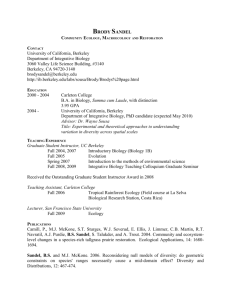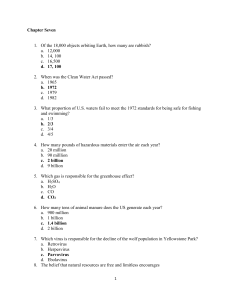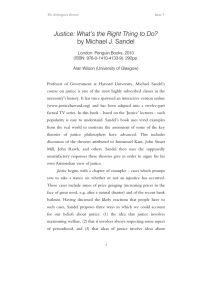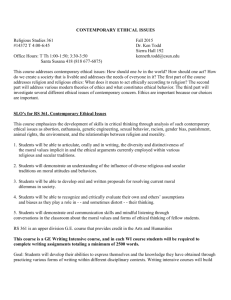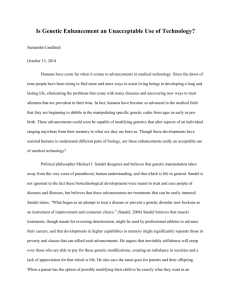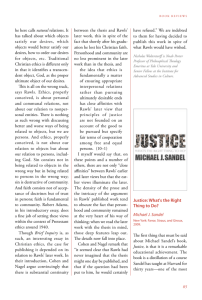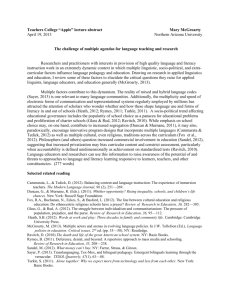What Money Can't Buy
advertisement
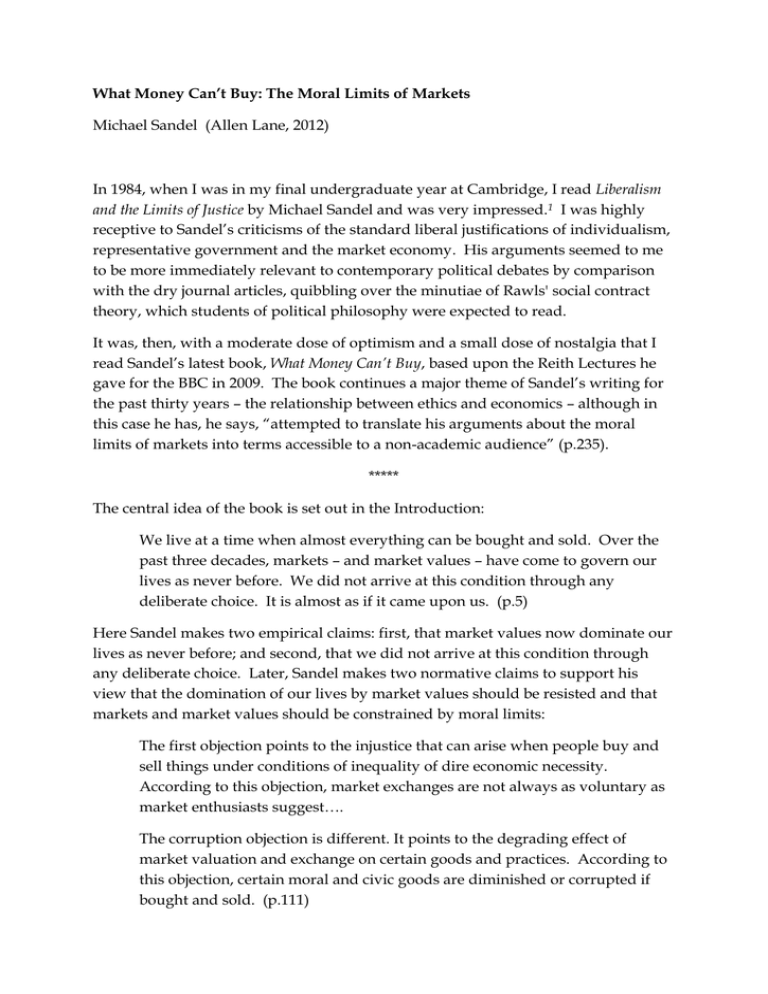
What Money Can’t Buy: The Moral Limits of Markets Michael Sandel (Allen Lane, 2012) In 1984, when I was in my final undergraduate year at Cambridge, I read Liberalism and the Limits of Justice by Michael Sandel and was very impressed.1 I was highly receptive to Sandel’s criticisms of the standard liberal justifications of individualism, representative government and the market economy. His arguments seemed to me to be more immediately relevant to contemporary political debates by comparison with the dry journal articles, quibbling over the minutiae of Rawls' social contract theory, which students of political philosophy were expected to read. It was, then, with a moderate dose of optimism and a small dose of nostalgia that I read Sandel’s latest book, What Money Can’t Buy, based upon the Reith Lectures he gave for the BBC in 2009. The book continues a major theme of Sandel’s writing for the past thirty years – the relationship between ethics and economics – although in this case he has, he says, “attempted to translate his arguments about the moral limits of markets into terms accessible to a non-academic audience” (p.235). ***** The central idea of the book is set out in the Introduction: We live at a time when almost everything can be bought and sold. Over the past three decades, markets – and market values – have come to govern our lives as never before. We did not arrive at this condition through any deliberate choice. It is almost as if it came upon us. (p.5) Here Sandel makes two empirical claims: first, that market values now dominate our lives as never before; and second, that we did not arrive at this condition through any deliberate choice. Later, Sandel makes two normative claims to support his view that the domination of our lives by market values should be resisted and that markets and market values should be constrained by moral limits: The first objection points to the injustice that can arise when people buy and sell things under conditions of inequality of dire economic necessity. According to this objection, market exchanges are not always as voluntary as market enthusiasts suggest…. The corruption objection is different. It points to the degrading effect of market valuation and exchange on certain goods and practices. According to this objection, certain moral and civic goods are diminished or corrupted if bought and sold. (p.111) These two normative claims are suggestive of two rather different ways in which the moral limits to market values could be set. The “fairness objection” draws on the idea that consent is only genuine when all participants to a decision are able to choose freely, with sufficient information and security to make well-informed decisions in pursuit of their interests. Inequalities in bargaining power, based on information asymmetries or economic disadvantages, undermine the possibility of truly voluntary choices by all parties and therefore, in some cases, market-based outcomes will lack genuine consent. There is a potential remedy, however, which requires the establishment of fair bargaining conditions for all parties: in cases where it can be shown that no party to the bargain was coerced into a poor choice by their poverty or ignorance, then the bargain may be considered truly voluntary and therefore acceptable. The “corruption objection” is not concerned with the way in which consent is established between parties, but rather with the nature of the goods over which the parties are bargaining. Here the claim is that certain goods are not appropriate for parties to buy and sell, regardless of the whether the bargaining conditions were fair or not. Treating certain goods – Sandel’s examples include friendship, marriage, children by adoption and college admission – as objects suitable to be bought and sold in the marketplace, demeans these goods, corrupting their true value. Even if we assume a society with no unjust differentials of power and wealth, there would still be, Sandel says, some things which money should not buy. Sandel’s book is full of examples, mostly drawn from contemporary American life, which are said to illustrate the extent to which market values, unconstrained by moral limits, have come to dominate everyday life. This transformation – which Sandel, borrowing an idea from Marx, describes as the “commodification of social life” (p.98) – has taken place, he says, without proper public debate about our shared values. He ends his book with an appeal for more discussion of these issues: Our only hope of keeping markets in their place is to deliberate openly and publicly about the meaning of the goods and social practices we prize. (p.202) In other words, we need less economics and more political philosophy. ***** Sandel’s complaint is not new. Ever since the start of the industrial revolution, aggrieved churchmen, radical journalists, conservative novelists, romantic poets and, more recently, an assortment of discontented academics have inveighed against the social consequences wrought by economic change. It comes as no surprise that Sandel’s description of the pervasive and pernicious influence of market values on our social and cultural life should draw on Marx’s idea of “commodification”. More surprising is that Sandel does not appear to notice that since language appropriate to describe phenomenon was already in use a century and a half ago then the phenomenon itself cannot plausibly be described as recent. What Sandel presents as a defining feature of social life during the past thirty years has, in fact, an almost three hundred year pedigree. This absence of historical perspective recurs in many of the examples with which Sandel illustrates his thesis. He is dismissive of the economic argument that giftgiving is a signalling mechanism, in which the value of the gift conveys previously private information to the receiver, indicating the esteem in which they are held (pp.98-107). He prefers an expressive account, in which the personal feelings of the giver are represented by the gift: what matters is not the value of the gift, but the time and attention spent selecting it. The growing practice of giving cash as a gift or cash equivalents in the form of gift cards - is, he says, a sign of the corruption of our conception of friendship. Yet, his expressive account of gift-giving only makes sense when we assume both a modern, Western conception of friendship and a society in which most people are sufficiently wealthy not to care about the economic value of the gifts they give and receive. When the Queen of Sheba visited King Solomon, there is no doubt that the gifts she brought were intended to signal both her wealth and her esteem for her host; neither is it likely that she selected all the gifts in person.2 A similar point can be made with regard to Sandel’s criticism of Gary Becker’s “economic analysis” of marriage. Sandel writes, Some think [Becker’s] calculating view takes the romance out of marriage. They argue that love, obligation, and commitment are ideals that can’t be reduced to monetary terms. They insist that a good marriage is priceless, something money can’t buy. (p.50) For most of human history marriage has had nothing to do with romance. Marriage was an "exchange of goods" in which the father gave his daughter to another man, who became her husband. Often a price was paid by the father, in the form of a dowry, since the wife was seen as a long-term cost, now transferred to the husband. Marriages were made to confirm treaties and to facilitate the transfer of land between families or tribes. The central theme of many great eighteenth and nineteenth century novels is the dilemma faced by women who would prefer to choose their husband based on character rather than lineage and acreage. Dorothea Brooke3 could, no doubt, have explained to Professor Sandel that marriage for love was made possible by modern capitalism: the market economy led both to a general rise in living standards and to the erosion of social distinctions based on family status, allowing men and women safely to follow their hearts. Sandel’s lack of historical perspective is compounded by a lack of precision in his account of the role of markets in modern society. In particular he confuses the idea of a price and the idea of a market. The price of a product (or service) is simply the charge that is made when the product changes hands. The price might or might not reflect the true cost of making and distributing the product; it might or might not be paid by the beneficiary of the product; it might or might not be set through some form of competitive exchange process, such as a market. Sandel discusses the case of a charity which offers to make a payment to women who are addicted to drugs if they agree to undergo sterilization (pp.43-47). The charity’s aim is to reduce the number of addicts giving birth to children, many of whom are unwanted and some of whom will suffer poor health from birth because of their mother’s drug habit. Sandel writes that, “[v]iewed as a market transaction, the deal produces gains for both parties and increases social utility” (p.45). This arrangement is, however, quite clearly not a market transaction. We might say that the charity is “putting a price” on the ability to conceive; but this price is not set by a competition between sterilisation providers. Rather, this is a clear case of a price without a market. The price paid to the women bears no clear relationship to the cost of performing the operation (presumably also paid for by the charity), nor the social cost of caring for an unwanted child, which would most likely be borne by taxpayers. The costs associated with the birth of children who suffer poor health, who are at serious risk of abuse or neglect, and many of whom end up being taken into care are high. These costs can and should be calculated, so that members of the community understand the financial consequences of the actions of women who become pregnant while addicted to drugs. It is only when the full economic and social costs of this problem become clear that the merits of the charity’s activities can be properly assessed. 4 The moral arguments about women’s fertility rights and the potentially coercive nature of an incentive payment to a vulnerable person, should be considered alongside the economic facts concerning the costs to the community of looking after unwanted children; only then could a sensible public policy be developed. At no point, however, do we need “to determine whether a woman’s reproductive capacity should be subject to a market transaction” (p.47), which is wholly irrelevant to this case. Markets are widely used mechanisms for setting prices and allocating goods, but they are not the only mechanism available for either of these activities. Prices can be set in other ways – by legal constraint, by tradition or convention, by auction – and goods can be allocated in other ways – by need, by merit, by place in a queue, or by lottery. The fact that a product has a price does not mean that it is part of a market transaction. Nor is the value of a product always determined by its price. Suppose I buy one of Usain Bolt’s gold medals: no-one will think that I was the fastest man over 100m at the 2012 London Games and Usain Bolt will remain the Olympic champion. I suspect that he would continue to accrue many benefits from wining the medal and that I would accrue very few from owning it. The point here is that while I could buy the medal I could not buy the meaning associated with the medal, which will always attach to Usain Bolt. ***** Sandel claims that many of the behaviours he describes as the intrusion of market values into social life have occurred recently, without public debate or discussion. He suggests that these corruptions of our social life have been foisted upon us without our consent. While this might be true in, say, China or Saudi Arabia, where there are no representative democratic institutions through which popular opinion can be expressed freely and openly, this is hardly a credible claim to make about the United States or Western Europe. In the West we allow people to have advertisements tattooed onto their foreheads, allow life insurance policies to be traded and allow corporate entities to sponsor luxury boxes at sports grounds (all examples of things that Sandel dislikes) because the majority of people regard these behaviours as acceptable in a free society, even if they themselves would not participate in such behaviour. Reading Sandel’s book it becomes clear that not only would he not participate in such behaviours, but he thinks that others should not be allowed to do so because of the harms such behaviours cause. Sandel thinks the allocation of goods according to the ability to pay is not fair on poorer people and he thinks that some goods should not be for sale under any circumstances. It is perfectly reasonable for someone to hold these views: they are old-fashioned, but that does not make them illogical. It is quite another thing, and quite unreasonable, for Sandel to claim that we have adopted these behaviours without due discussion and debate. During a conversation held in May 1835, Alexis de Tocqueville reported that John Stuart Mill had told him that, The taste for making others submit to a way of life which one thinks more useful for them than they do themselves is not a common taste in England.5 We do not forbid these behaviours because we have not been persuaded, by Sandel or anyone else, that they are harmful rather than distasteful. In an astute analogy, Bernard Williams classifies the critics of Rawls' social contract theory along the same lines as the Hegelian critics of Kant’s philosophy. Williams identifies Alasdair MacIntyre as an exemplar of the "Right Hegelian" response to Rawls and Charles Taylor as an exemplar of the "Left Hegelian" response. In a waspish aside, he says of Michael Sandel, The rhetoric of his criticism [of Rawls] is on the strongest Right Hegelian lines, but some of his political preferences seem distinctly to the Left of that.6 When I first read Sandel, nearly thirty years ago, I would have resisted Williams' suggestion that Sandel was a progressive cloaked in traditional garb. Having read his most recent book, I now suspect that he is a conservative dressed as a radical. Once I was very impressed; not any more. Mark Hannam January 2013 Michael Sandel, Liberalism and the Limits of Justice, Cambridge University Press, 1982. As described in 1 Kings 10: 1-13. 3 The heroine of George Eliot’s Middlemarch, first published in 1874. Mary Wollstonecraft's Maria, or The Wrongs of Women, published in 1798, is also pertinent. 4 Calculating the cost of providing social care for children is not easy. A report published by the UK Department of Health in 2000 (www.pssru.ac.uk/pdf/B062.pdf) on how to calculate this cost ran to 90 pages. A report published by the UK Parliament's Children, Schools and Families Committee in 2009 (http://www.publications.parliament.uk/pa/cm200809/cmselect/cmchilsch/111/111i.pdf) estimated that the average cost of looking after a child in residential care in the UK was £2,428 per week, or £126,256 per year, (see Para 13, p.21). 5 Alexis de Tocqueville, Journeys to England and Ireland, Yale University Press, 1958, p.81. 6 Bernard Williams 'Pluralism, Community and Left Wittgenstinianism", In the Beginning Was the Deed, Princeton University Press, 2005, p.32. 1 2
